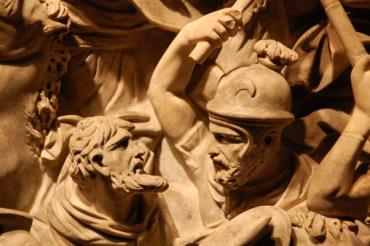The northern barbarians – Goths, Huns et al.
6.1 Introduction: Mapping ‘Barbaricum’

Romans v. barbarians as depicted on the Portonaccio Sarcophagus (c. 180). The legionary insignia of Legio IIII Flavia (the eagle, top centre) and Legio I Italica (the fragmentary boar, top right) help us to identify the Roman fighters. Museo Massimo delle Terme, Rome.
Photo © S. Kershaw
Food for thought:
The face of the figure on the far left has not been carved. Can you suggest why not?

Romans v. barbarians (Marcomanni) as depicted on the Portonaccio Sarcophagus (c. 180). Museo Massimo delle Terme, Rome.
Photo © S. Kershaw
Across the fourth century we have witnessed the importance not just of Rome’s relations with a variety of ‘barbarian’ tribes, but also the importance for Rome of ‘inter-barbarian’ tribal relationships. So now, as we enter the second half of the course, we take a closer look at the peoples of ‘Barbaricum’ north of the Rhine and Danube. In doing so we will cover issues of identity and ethnicity (primarily pertaining to Romans and barbarians), which have received a good deal of scholarly attention in recent years.
With our prime focus on the Goths and the Huns, studied through a variety of literary and archaeological sources, we will explore Roman attitudes towards barbarians and barbarian attitudes towards Romans, and try to formulate some ideas on what it means to be Roman or barbarian.
Video: Barbarians
Individual activity: The inhabitants of ‘Barbaricum’
Quickly reread Christie, pp. 30–35 (New Conflicts and Responses), and Goldsworthy, pp. 104–9 (The Germans). Make a note of the main tribes and groups in the ‘Barbaricum’ that are mentioned in Christie’s text.
Then consult:
- Christie, Map of the Western Roman Empire c AD 400 (pp. xii–xiii)
- Goldsworthy, Map 6, The empire of Valentinian and Valens (p. 239); Map 9, The initial barbarian invasions in the fifth century (pp. 308–9)
- Kershaw, Map 8, The Barbarian Invasions of the Fifth Century CE (pp. xxiv-xxv); and/or a map of The Roman Empire about 395 from the online Perry-Castañeda Library Map Collection at the University of Texas Libraries.
Then download and print a blank map of Imperium Romanum from the Ancient World Mapping Center. On your map, mark the locations of the following tribes in the second half of the fourth century:
- Picti
- Vandals
- Jutes
- Sarmatians
- Angles
- Tervingi/Visigoths
- Saxons
- Greuthungi/Ostrogoths
- Franks
- Alani
- Burgundiones
- Huns
- Alemanni/Alamanni
- Marcomanni
- Quadi
- Heruli
- Suebi